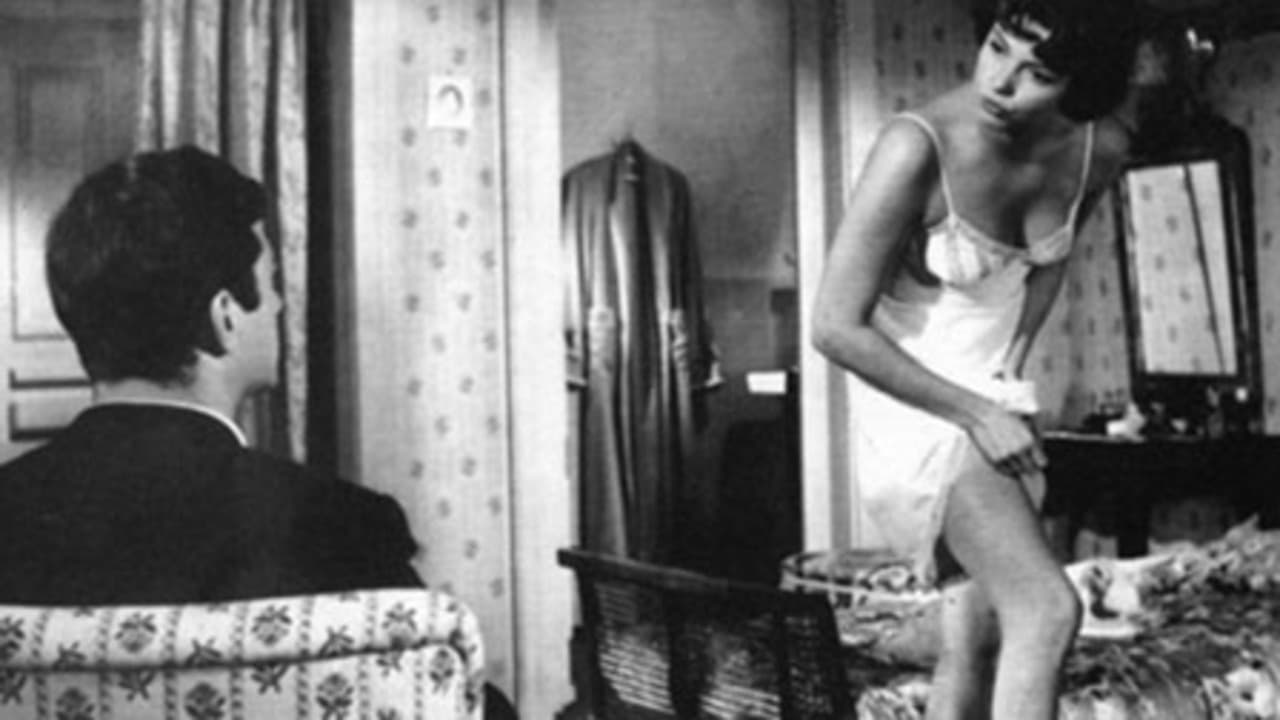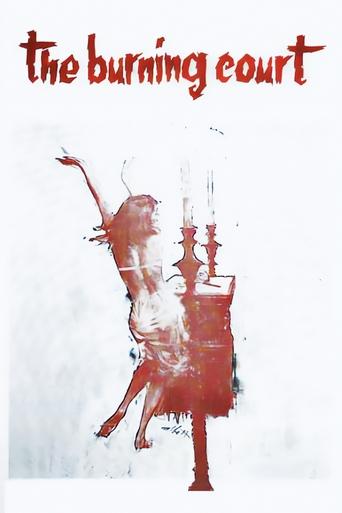

Taking a look at writer/directing auteur Julien Duvivier's IMDb page after recently re- watching his amazing Film Noir Chair De Poule,I was delighted to find out that Duvivier had directed a Horror title,which led to me excitingly getting ready to enter Duvivier's court.The plot-The 18th century:As a woman and her 2 brothers are burnt at the stake for allegedly being involved in witchcraft.The woman uses her dying breath to put a curse on the lover who betrayed her,with the woman telling the man,that he and all future generations related to him,will experience horrible,violent deaths.The present:Paying a visit to his uncles mansion with his brother Marc, Stéphane Desgrez is caught by surprise,when a historian called Michel Boissard is invited to the mansion,with Boissard revealing that he is visiting the mansion,due to its "cursed" history being something which would be a perfect fit for his magazine.Knowing that Marc and Stephane have come down to pay him a friendly visit solely to get back in his will,the uncle tells nurse Myra that he does not want to see either of them.Taking Boissard on a tour of the mansion, Stephane becomes agitated when Boissard begins to ask him about urban legends related to letters related to the curse,which are said to be hidden in the mansion,that causes Stephane to put his foot firmly down and state that the urban legends are complete rubbish. Quietly meeting his uncle,Marc is asked by his uncle to keep Stephane as far away from him as possible.After eating a huge meal,Marc, Stephane and their wives decide to leave their uncle at the mansion,and attend a party being held that night.Later that night:Entering the mansion,a maid goes to the kitchen to gather the uncles nightly medicine.Being unable to find the medicine,the maid decides to pay a visit to the uncles bedroom,where she is left completely speechless,when she sees the ghost of the curse woman giving the uncle some burning medicine.View on the film:Showing the mansions shadow to cover up any positive attributes that the characters may have,co-writer/ (along with John Dickson Carr and Charles Spaak)director Julien Duvivier builds an extraordinary atmosphere which mixes gritty Gothic Horror with harsh Film Noir,as Duvivier shows the light attempting to brighten up the mansion,to be unrelentingly stark,with the light revealing the real monsters that inhabit the place.Slowly allowing for a thick mist to appear on the mansions horizons, Duvivier and cinematographer Roger Fellous expertly use quick tracking shots to unleash a tense Supernatural Horror mood,which leads to the characters and the viewer being unsure if a stranger seen from a distance is part of their imagination, or if it's the urban legend coming to life.For the screenplay,the writers show a tremendous skill in increasing the Horror and Film Noir pressure as the characters gradually sink into darkness,thanks to Marc and Stéphane playful arguments being shown to contain an unforgiving sting.Along with Marc and Stephane's relationship,the writers smartly use the Gothic Horror route as a way to give the title a strong mystery edge,which leads to the movie striking with a wonderfully cynical final note.Entering the movie with a straight lace shine (and backed by an icy score from Georges Auric) ,the great Jean-Claude Brialy shows the perfection on Marc's face to crack into a 1000 pieces,as the horror related to the family curse,leads to horrors that Marc attempts to hide,to rise from the dead. Initially appearing to be rather playful,the terrific Claude Rich shows Stéphane face to turn to stone,as he discovers Marc's hidden horrors,and looks into the burning court.
... View MoreIn retrospect we can speculate that Duvivier, a giant, reacted in a similar manner to Gulliver when the pygmies - in this case the spoiled brats responsible for the New Wavelet - attempted to subdue him. He had begun the sixties, which would turn out to be his last decade, by taking one of Truffaut's non-acting favorites and actually getting a performance out of him in 'Boulevard' and this time around he again used a couple of 'modern' actors in Scoob and Leaud. With Charles Spaak, a well-tried collaborator, he fashioned a hybrid of Mystery and Supernatural from a 'classic' John Dickson Carr novel and one which no admirer of Duvivier should miss. Clearly the 'problems' surrounding Black Jack had been left behind and here we get tantalizing glimpses of the old Master albeit paying for it via the abrupt ending. It's not first-rate Duvivier but even his second-rate leaves the New Wavistas dead in the water.
... View MoreAnother "victim" of the French Nouvelle Vague - a distinguished film director who found himself unceremoniously falling out of fashion within critical circles - was undoubtedly Julien Duvivier. Admittedly, his best work was behind him by then in such classic films like PEPE LE MOKO' (1937), UN CARNET DE BAL (1937; one of Michael Caine's favorite films!) and PANIQUE (1947; a rumored upcoming Criterion DVD release) but, if this obscure but richly rewarding suspenser is any indication, his cinematic and narrative skills did not desert him with age.Apparently, the original source novel by John Dickson Carr is a celebrated (and much more sophisticated) literary piece but even if this film adaptation (by renowned screenwriter Charles Spaak) constitutes an oversimplification, one cannot deny the fact that it is highly polished entertainment nevertheless. The plot ingeniously combines two prolific subgenres in the horror film lexicon, "the old dark house" and "the witch's curse", dealing as it does with an 18th Century witch being deceived by her lover - a policeman dressed as a monk! - thereby unleashing a vengeful curse on his ancestors which decrees that every subsequent head of the family dies a violent death. This event is not depicted in the film but merely referred to throughout and we immediately jump into the present with a female ancestor of the witch - played by the beautiful Edith Scob from Georges Franju's EYES WITHOUT A FACE (1959), here with her hair bleached blonde - being invited with her novelist husband to a château in the country which, as it happens, is owned by the ancestors of the witch's duplicitous lover. The latter are a despicable bunch of amoral opportunists with the two young heirs greedily awaiting the demise of their cantankerous 75-year old uncle which could occur at any moment. One night, every member of the household (including his nurse) desert the old man for their own egotistical purposes and Scob and her husband volunteer to stay home and watch over him themselves... Apart from the illustrious trio in the behind-the-camera personnel (Duvivier, Spaak and music composer Georges Auric), the film boasts atmospheric lighting by Roger Fellous and a cast of willing performers: the afore-mentioned Scob, Jean-Claude Brialy (as the more level-headed of the two heirs), Claude Rich (as his worthless playboy brother), Nadja Tiller (as the lovely nurse who, ultimately, is not as loyal as she makes out to be), etc. There are elements of the supernatural (when the murderer is seen passing through the walls of a closed room by the housekeeper or when the body vanishes from the interred coffin and reappears sitting in a chair in the family chapel) and black comedy (when the mourners at the funeral waltz around the still open coffin at the deceased's own request) involved which only add to the fun. It would be a mistake to reveal more of the twists and turns the plot takes in the second half of the film - which also introduces the character of a no-nonsense police inspector - but I'll say only that it all ends rather too abruptly perhaps (immediately after the ironic final revelation) leaving the fate of some of the major characters pretty much unresolved.
... View More"The Burning Court" may be the most fascinating detective story ever written.After reading it,W.B. Yeats called Carr,the James Joyce of mystery writers.(Remember Yeats had very ambiguous feelings about Joyce's art.) Understandably, Carr never tried to repeat his structural technique a second time. He had done something which once done could not be repeated and ,furthermore ,did not readily lend itself to adaptation in any other media form. The book opens with a quotation from Shakespeare,"There was a young man who lived by a churchyard;but that's an unfinished story," and accordingly ends in mid-sentence,most of three hundred pages later.In some editions the last words{"Defense attorneys already claiming newly discovered evidence...")are deliberately run into the end of the page.Carr intentionally conned his readers into believing the last page was deleted.Long,long afterwards,comes the sudden flash ,and the belated certainty. that we ,like the ever more frenzied characters, have been utterly deceived.Carr sets his diabolical puzzle within an extremely formal five part structure."Indictment","Prosecution","Defense","Summing-Up" and "Verdict".Each of the first four sections builds to a logical climax at the end of which all the expectations which the author have previously built up(four times in turn!) are once again successively destroyed. The author's primary ploy is that we are never to be quite certain whether he is telling us a detective story masquerading as a horror story or a horror story masquerading as a problem in logic.In the latter case,we have no right to expect a rational solution and the identity of the reincarnated witch becomes increasingly obvious. However,every alleged supernatural event and every supposed pre-natal memory,is,at some subsequent point or other,given a perfectly rational and satisfying explanation...except that these belated witnesses (in their turn) may be,likewise, either inaccurate or mendacious.By the way,Carr always insisted that he had very subtly inserted the solution to all this in one phrase casually inserted between a pair of commas but apparently went to his grave without informing posterity between which two commas the true answer could be found.The question of what compelled Duvivier, an often splendid director,(and in many other instances a still shamefully underrated artist)to film this work is another mystery which was, mercifully,carried to his grave.He began by scrapping the structure(a little like taking a stream of consciousness novel and shooting it in chronological sequence)and moving the locale from jazz age Philadelphia to country France!And it goes down from there. Whatever the correct solution to Carr's riddle,we can be sure that this isn't it. There has been nothing this bad in cinema literary massacre since another great master of mystery,Alfred Hitchcock,decided to improve O'Casey's "Juno and the Paycock".To make matters worse,at approximately the same time that Duvivier launched his ill-starred version,a husband and wife team succeeded,despite the formidable structural difficulties,in winning the Emmy with their adaptation of the same work.Unfortunately it does not appear in the IMDb and has, apparently, never been re-shown.If it survives,it must be worth a close look.
... View More